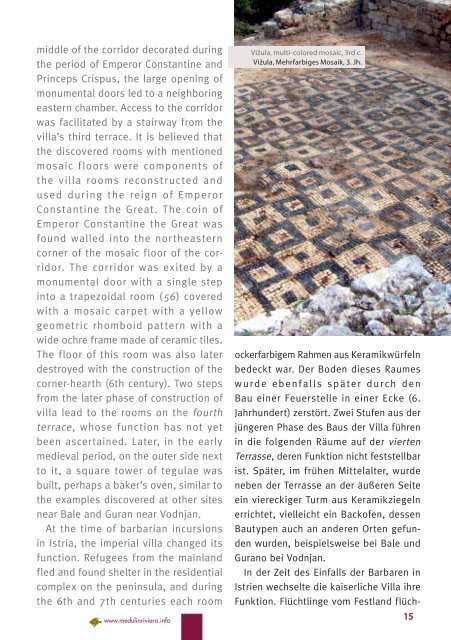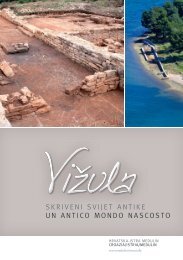Führer über die versteckte Welt des antiken Vižula - Medulin Riviera ...
Führer über die versteckte Welt des antiken Vižula - Medulin Riviera ...
Führer über die versteckte Welt des antiken Vižula - Medulin Riviera ...
Sie wollen auch ein ePaper? Erhöhen Sie die Reichweite Ihrer Titel.
YUMPU macht aus Druck-PDFs automatisch weboptimierte ePaper, die Google liebt.
middle of the corridor decorated during<br />
the period of Emperor Constantine and<br />
Princeps Crispus, the large opening of<br />
monumental doors led to a neighboring<br />
eastern chamber. Access to the corridor<br />
was facilitated by a stairway from the<br />
villa’s third terrace. It is believed that<br />
the discovered rooms with mentioned<br />
mosaic f loors were components of<br />
the villa rooms reconstructed and<br />
used during the reign of Emperor<br />
Constantine the Great. The coin of<br />
Emperor Constantine the Great was<br />
found walled into the northeastern<br />
corner of the mosaic floor of the corridor.<br />
The corridor was exited by a<br />
monumental door with a single step<br />
into a trapezoidal room (56) covered<br />
with a mosaic carpet with a yellow<br />
geometric rhomboid pattern with a<br />
wide ochre frame made of ceramic tiles.<br />
The floor of this room was also later<br />
<strong>des</strong>troyed with the construction of the<br />
corner-hearth (6th century). Two steps<br />
from the later phase of construction of<br />
villa lead to the rooms on the fourth<br />
terrace, whose function has not yet<br />
been ascertained. Later, in the early<br />
me<strong>die</strong>val period, on the outer side next<br />
to it, a square tower of tegulae was<br />
built, perhaps a baker’s oven, similar to<br />
the examples discovered at other sites<br />
near Bale and Guran near Vodnjan.<br />
At the time of barbarian incursions<br />
in Istria, the imperial villa changed its<br />
function. Refugees from the mainland<br />
fled and found shelter in the residential<br />
complex on the peninsula, and during<br />
the 6th and 7th centuries each room<br />
<strong>Vižula</strong>, multi-colored mosaic, 3rd c.<br />
<strong>Vižula</strong>, Mehrfarbiges Mosaik, 3. Jh.<br />
ockerfarbigem Rahmen aus Keramikwürfeln<br />
bedeckt war. Der Boden <strong>die</strong>ses Raumes<br />
w urde ebenf all s später durch den<br />
Bau einer Feuerstelle in einer Ecke (6.<br />
Jahrhundert) zerstört. Zwei Stufen aus der<br />
jüngeren Phase <strong>des</strong> Baus der Villa führen<br />
in <strong>die</strong> folgenden Räume auf der vierten<br />
Terrasse, deren Funktion nicht feststellbar<br />
ist. Später, im frühen Mittelalter, wurde<br />
neben der Terrasse an der äußeren Seite<br />
ein viereckiger Turm aus Keramikziegeln<br />
errichtet, vielleicht ein Backofen, <strong>des</strong>sen<br />
Bautypen auch an anderen Orten gefunden<br />
wurden, beispielsweise bei Bale und<br />
Gurano bei Vodnjan.<br />
In der Zeit <strong>des</strong> Einfalls der Barbaren in<br />
Istrien wechselte <strong>die</strong> kaiserliche Villa ihre<br />
Funktion. Flüchtlinge vom Festland flüch-<br />
15



